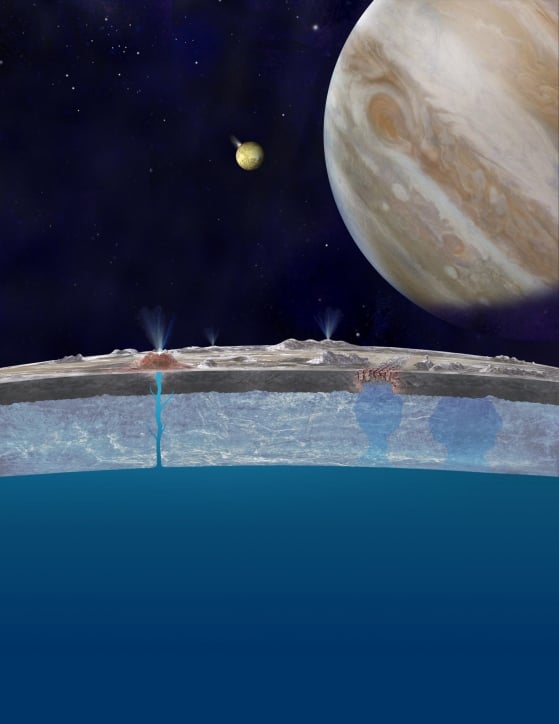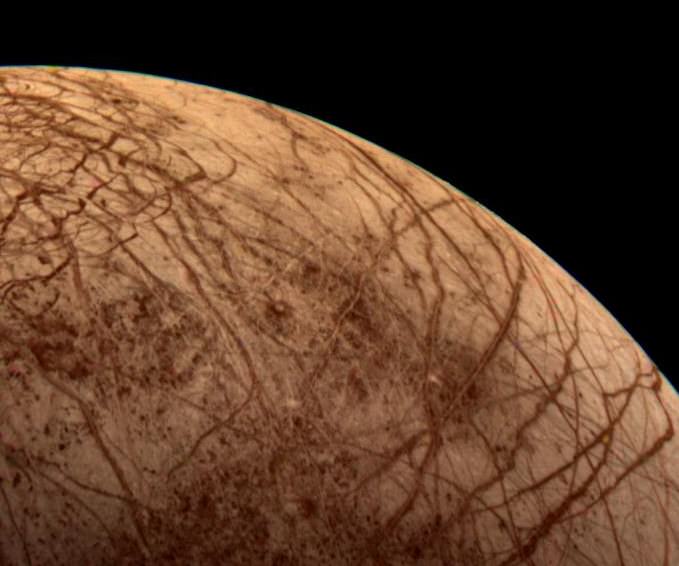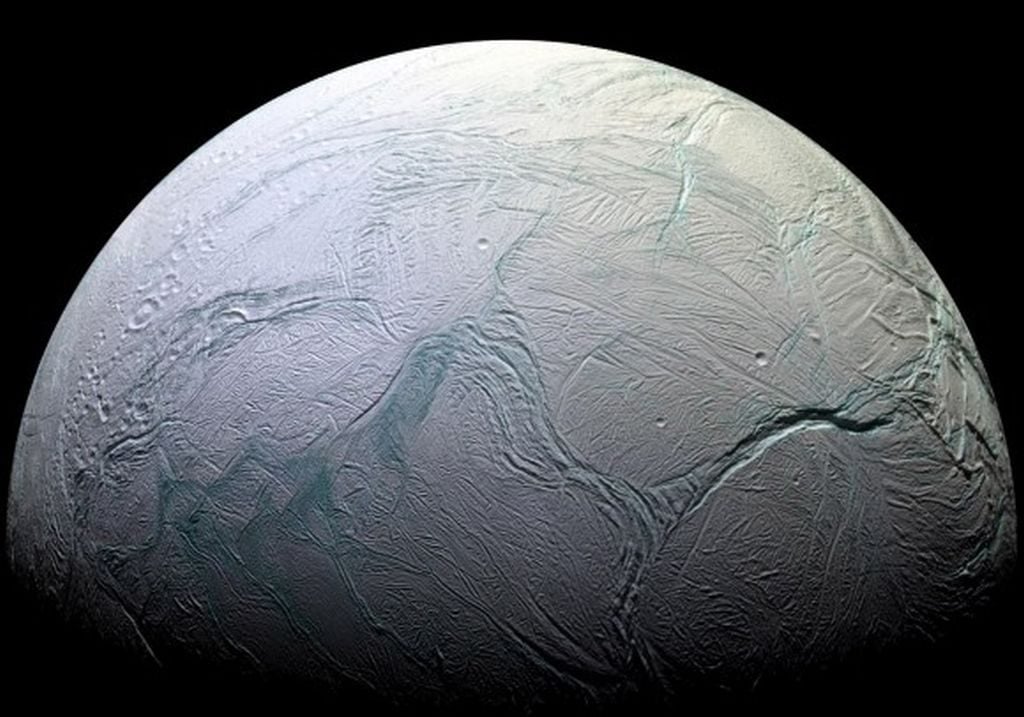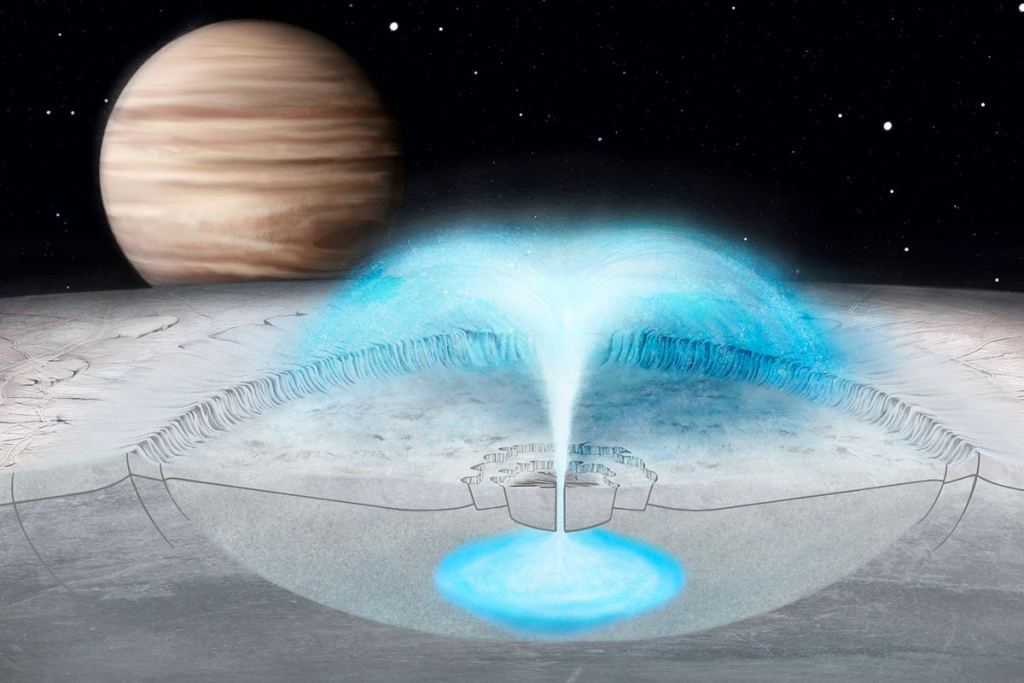Welcome back to our Fermi Paradox series, where we take a look at possible resolutions to Enrico Fermi’s famous question, “Where Is Everybody?” Today, we examine the possibility that the reason for the Great Silence is that most life out there exists in warm water oceans under sheets of ice!
In 1950, Italian-American physicist Enrico Fermi sat down to lunch with some of his colleagues at the Los Alamos National Laboratory, where he had worked five years prior as part of the Manhattan Project. According to various accounts, the conversation turned to aliens and the recent spate of UFOs. Into this, Fermi issued a statement that would go down in the annals of history: " Where is everybody? "
This became the basis of the Fermi Paradox, which refers to the disparity between high probability estimates for the existence of extraterrestrial intelligence (ETI) and the apparent lack of evidence. Since Fermi's time, there have been several proposed resolutions to his question, which include the possibility that Oceans Worlds (and not rocky planets) might be the best candidates for finding life.
The term "Ocean World" (not to be confused with " Waterworld ") refers to astronomical bodies that have icy surfaces and interior oceans. Within the outer Solar System, there are multiple moons that fit this description, including Jupiter's moons Europa, Ganymede, Callisto, Saturn's moons Enceladus, Titan, Dione, Mimas, Neptune's Triton, and maybe even Pluto, Ceres, and some of the larger Kuiper Belt Objects.
Copernican vs. Anthropic
Related to this hypothesis is the ongoing debate between proponents of the Copernican Principle and the Anthropic Principle. The former states that if something is randomly-sampled, it is likely to be representative of the majority rather than being rare or unique. In the realm of astronomy and cosmology (where it is called the Cosmological Principle), it argues that Earth-like planets (and terrestrial life) are common in our Universe.
The Anthropic Principle essentially argues the opposite of the Cosmological Principle and holds that observations made of the Universe are entirely dependent on its laws being conducive to life. As David Brin would describe it in the context of the Fermi debate:
“The philosophical counter to the principle of mediocrity is the ‘Anthropic Principle,’ which proposes that it is possible, even in a great and diverse Universe, for an observer to witness a special place and time, especially if the special attribute is required for there to be an observer in the first place… Uniqueness advocates see nothing wrong with the proposal that the intelligent life we see on Earth is rare.”
In Rock or in Ice?
One of the main questions that keeps coming up during the whole Fermi debate is "are we looking in the right places?" When it comes right down to it, the Search for Extraterrestrial Intelligence (SETI) is plagued by a frame of reference problem. To put it succinctly, the only planet we know that is capable of supporting life (as we know it) is Earth and the only technologically-advanced species that we know of is ourselves.
Ergo, when searching for potentially-habitable exoplanets, astronomers are confined to looking for "Earth-like" planets (which is something of a loaded term). What that boils down to is terrestrial planets (rocky) that have dense atmospheres and are warm enough to have flowing water on their surfaces. Certain biosignatures such as oxygen gas, carbon dioxide, methane, and other chemicals we associate with life are looked for as well.
However, there is a growing chorus within the scientific community that holds this view to be both limited and limiting. To illustrate, there's the search for life that is going on right now in the Solar System, which is almost entirely focused on Mars. But past the Frost Line, the theoretical boundary in the Solar System beyond which volatiles can exist in solid form, there are icy moons that might harbor life in their interiors.
Origin
In 1979, the Voyager 1 and 2 missions passed through the Jovian system and took detailed photos of Europa's surface. These photos are what led scientists to consider the possibility that this icy moon might have an interior ocean. Since then, the evidence for this has mounted considerably and, combined with data indicating the presence of surface plumes, has bolstered the case for there being life inside.
The discovery of similar conditions on other Jovian moons, several of Saturn's moons, and other icy bodies that orbit gas giants or in the Kuiper Belt have led many in the scientific community to speculate that these bodies could be the most promising place to look for life beyond Earth. In recent years, this argument has been extended by astronomers and astrobiologists to the interstellar realm.
One such person is Dr. Lynnae C. Quick, a NASA planetary scientist and a member of the Dawn, Europa Clipper*, and Dragonfly* science teams. She is also a member of the NASA Solar System Exploration Research Virtual Institute 's (SSERVI) Toolbox for Research and Exploration (TREX) science team, NASA's Roadmaps to Ocean Worlds (ROW), and the Outer Planets Assessment Group 's (OPAG) Steering Committee.
As she explained in a recent NASA press release (dated June 18th):
"Plumes of water erupt from Europa and Enceladus, so we can tell that these bodies have subsurface oceans beneath their ice shells, and they have energy that drives the plumes, which are two requirements for life as we know it. So if we’re thinking about these places as being possibly habitable, maybe bigger versions of them in other planetary systems are habitable too." "If we see that a planet’s density is lower than Earth’s, that’s an indication that there might be more water there and not as much rock and iron. But if a planet’s surface temperature is less than 32 degrees Fahrenheit (0 degrees Celsius), where water is frozen, then we have an icy ocean world, and the densities for those planets are even lower."
The goals of the ROW group were spelled out during a presentation titled " Exploration Pathways for Europa after initial In-Situ Analyses for Biosignatures," which was made on Feb. 27th, 2017, at the NASA-hosted " Planetary Science Vision 2050 Workshop." They include searching for biosignatures on Europa, analysis of near-subsurface material and depth estimates of its ocean, and characterizing surface/subsurface properties.
As Kevin Peter Hand - the Deputy Chief Scientist for Solar System Exploration at NASA's Jet Propulsion Laboratory - explained during the course of the presentation, these three goals are intertwined:
“Were biosignatures to be found in the surface material, direct access to, and exploration of, Europa’s ocean and liquid water environments would be a high priority goal for the astrobiological investigation of our Solar System. Europa’s ocean would harbor the potential for the study of an extant ecosystem, likely representing a second, independent origin of life in our own solar system. Subsequent exploration would require robotic vehicles and instrumentation capable of accessing the habitable liquid water regions in Europa to enable the study of the ecosystem and organisms.”
Similar arguments were made by Manasvi Lingam and Abraham Loeb, two researchers from the Harvard Smithsonian Center for Astrophysics (CfA) and the Institute for Theory and Computation (ITC) at Harvard University. In a 2018 study, titled " Subsurface Exolife," the two challenged traditional notions of habitability using the icy moons of Jupiter, Saturn, and other gas giants as examples.
As Prof. Loeb summarized this case for Universe Today via email back in Dec. of 2017, stating:
“The conventional notion of planetary habitability is the habitable zone (HZ), namely the concept that the “planet” must be situated at the right distance from the star such that it may be capable of having liquid water on its surface. However, this definition assumes that life is: (a) surface-based, (b) on a planet orbiting a star, and (c) based on liquid water (as the solvent) and carbon compounds. In contrast, our work relaxes assumptions (a) and (b), although we still retain (c).”
Possible Resolution?
Alan Stern, the Associate Vice President of the Southwest Research Institute (SwRI) and the Principle Investigator of the NASA *New Horizons* mission, suggested that this could even a possible resolution to the Fermi Paradox. During the Habitable Worlds 2017 Workshop hosted by NASA's Nexus for Exoplanet System Science (NExSS), he conducted a presentation titled " An Answer to Fermi’s Paradox In the Prevalence of Ocean Worlds?"
Central to Stern's presentation was the hypothesis that the great majority of planets in our galaxy that have given rise to life and civilizations are interior ocean worlds. Due to their icy crusts, these civilizations would be unable to communicate with other planets using methods we might recognize (like radio transmitters). But seeing as how these civilians would be aquatic, it's unlikely they would rely on technologies similar to our own.
These arguments are reminiscent of what Charles Lineweaver of the Australian National University argued in his 2007 paper, " Paleontological Tests: Human-like Intelligence is not a Convergent Feature of Evolution. " In this paper, Lineweaver drew upon his many years of teaching about the Drake Equation to make the case for non-convergent evolution, stating that intermediate stages do not necessarily produce "inevitable" outcomes.
Citing conversations he had with Drake, Carl Sagan, and Simon Conway-Morris, he asserted that this is a common assumption in SETI research:
"What Drake, Sagan, and Conway-Morris have done is interpret correlated parallel moves in evolution as if they were unconstrained by shared evolution but highly constrained by a universal selection pressure towards intelligence that could be extrapolated to extraterrestrials."
Similarly, Lineweaver showed how creatures with high Encephalization Quotients (E.Q.) - the ratio of brain weight to an exponent of body weight - will not inevitably develop technology or attempt to engage in interstellar communications:
"The most intelligent protostome is probably the octopus. After 600 million years of independent evolution and despite their big brains, octopi do not seem to be on the verge of building radio telescopes. The dolphinoidea evolved a large E.Q. between ~60 million years ago and ~20 million years ago (Marino et al 2004). Thus, dolphins have had ~20 million years to build a radio telescope and have not done so. This strongly suggests that high E.Q. may be a necessary, but is not a sufficient condition for the construction of radio telescopes. Thus, even if there were a universal trend toward high E.Q., the link between high E.Q. and the ability to build a radio telescope is not clear. If you live underwater and have no hands, no matter how high your E.Q., you may not be able to build, or be interested in building, a radio telescope."
This argument certainly applies as far as the Ocean Worlds Hypothesis is concerned. In the end, it could be that intelligent life is not rare at all, but that it's simply unable to communicate with us.
Implications and Criticism
The immediate and obvious implication of this hypothesis are that all of our current SETI efforts (which rely on searching for radio transmission in the cosmos) will not succeed. If life is statistically more likely to emerge on icy bodies with interior oceans at their core-mantle boundary, then finding evidence of this life will require a much more active approach.
In the coming years, NASA plans to send an orbiter to Europa (the Europa Clipper mission) which will analyze the moon's surface in the hopes of learning more about its composition, monitor plume activity, and look for biosignatures. The data obtained by this mission will also inform possible future missions to the surface, such as NASA's proposed Europa Lander.
This mission would examine the surface of Europa for biomarkers, most likely from a spot adjacent to an active plume. There have even been multiple proposals made over the past few decades for a robotic submarine that would investigate Europa's interior ocean. Similar proposals have been made for exploring Enceladus and other Ocean Worlds.
In all cases, this presents serious ethical considerations. Whereas it is natural to want to get a closer look at Ocean Worlds in our Solar System to determine if there is life within them, the prospect of sending missions to explore them directly would threaten any life there. Such is the paradox of planetary protections, where the search for life entails the risk of contaminating and endangering it.
In terms of drawbacks, the Ocean Worlds hypothesis raises the all-important Copernican Principle (aka. Cosmological Principle). If most life in the Universe is to be found inside icy planets and moons, then planet Earth, terrestrial life, and humanity are atypical and are in a unique and advantageous position to observe the cosmos - which is consistent with the Anthropic Principle.
What's more, it implies an imperative or even a duty for humanity to seek out life if it wants to make contact. Otherwise, the Fermi Paradox will endure because other life forms are unable to contact us. But if in so doing, we run the risk of contaminating and destroying any life we find, are we not better off letting it endure? All good questions, and one which help to frame the ethical questions that searching for extraterrestrial life raises.
These questions absolutely must be addressed before humanity starts sending robotic missions to Europa and other "Ocean Worlds." If these are the only places we're likely to find extraterrestial life in our Solar System or the Universe at large, perhaps it would be best to explore them from orbit or just leave them alone entirely. Luckily for us, it will be many years before a Europa submarine (or similar missions) would even be on the table.
Also, a number of next-generation telescopes will become operational this decade (like the James Webb* and Nancy Grace Roman Space Telescope*) that will gather a great deal more information on potentially-habitable exoplanets. So in addition to having time to discuss the ethical considerations thoroughly, we will also be able to place tighter constraints one where life could be found in the coming years.
In the meantime, be sure to check out this cool infographic about the Ocean Worlds in our Solar System, courtesy of NASA JPL Infographics:
We have written many interesting articles about the Fermi Paradox, the Drake Equation, and the Search for Extraterrestrial Intelligence (SETI) here at Universe Today.
Here's Where Are The Aliens? How The ‘Great Filter’ Could Affect Tech Advances In Space, Why Finding Alien Life Would Be Bad. The Great Filter, How Could We Find Aliens? The Search for Extraterrestrial Intelligence (SETI), and Fraser and John Michael Godier Debate the Fermi Paradox.
Want to calculate the number of extraterrestrial species in our galaxy? Head on over to the Alien Civilization Calculator!
And be sure to check out the rest of our Beyond Fermi's Paradox series:
- Beyond “Fermi’s Paradox” I: A Lunchtime Conversation- Enrico Fermi and Extraterrestrial Intelligence
- *Beyond “Fermi’s Paradox” II: Questioning the Hart-Tipler Conjecture*
- Beyond “Fermi’s Paradox” III: What is the Great Filter?
- Beyond “Fermi’s Paradox” IV: What is the Rare Earth Hypothesis?
- Beyond “Fermi’s Paradox” V: What is the Aestivation Hypothesis?
- Beyond “Fermi’s Paradox” VI: What is the Berserker Hypothesis?
- Beyond “Fermi’s Paradox” VII: What is the Planetarium Hypothesis?
- Beyond “Fermi’s Paradox” VIII: What is the Zoo Hypothesis?
- Beyond “Fermi’s Paradox” IX: What is the Brief Window Hypothesis?
- Beyond “Fermi’s Paradox” X: What is the Firstborn Hypothesis?
- Beyond “Fermi’s Paradox” XI: What is the Transcension Hypothesis?
- Beyond “Fermi’s Paradox” XII: What is the Water Worlds Hypothesis?
- Beyond “Fermi’s Paradox” XIV: What is the Aurora Hypothesis?
- Beyond “Fermi’s Paradox” XV: What is the Percolation Theory Hypothesis?
- Beyond “Fermi’s Paradox” XVI: What is the “Dark Forest” Hypothesis?
- Beyond “Fermi’s Paradox” XVII: What is the “SETI-Paradox” Hypothesis?
Astronomy Cast has some interesting episodes on the subject. Here's Episode 24: The Fermi Paradox: Where Are All the Aliens?, Episode 110: The Search for Extraterrestrial Intelligence, Episode 168: Enrico Fermi, Episode 273: Solutions to the Fermi Paradox.
Sources:
- Brin, G.D. "The Great Silence – the Controversy Concerning Extraterrestrial Intelligent Life." Quarterly Journal of the Royal Astronomical Society, Vol. 24, No.3 (1983)
- Lineweaver, C. "Paleontological Tests: Human-like Intelligence is not a Convergent Feature of Evolution." From Fossils to Astrobiology (2007)
- Stern, A. S. "An Answer to Fermi’s Paradox In the Prevalence of Ocean Worlds? " American Astronomical Society, Division of Planetary Sciences (DPS) meeting (2017)
- Zeng, L. (et al.) "Growth Model Interpretation of Planet Size Distribution." Proceedings of the Royal Astronomical Society (2019)
- Nisr, C. (et al.) "Large H2O solubility in dense silica and its implications for the interiors of water-rich planets." Proceedings of the Royal Astronomical Society (2020)
- Quick, L. (et al.) "Forecasting Rates of Volcanic Activity on Terrestrial Exoplanets and Implications for Cryovolcanic Activity on Extrasolar Ocean Worlds." Publications of the Astronomical Society of the Pacific, Vol. 132, No. 1014 (2020)
 Universe Today
Universe Today








